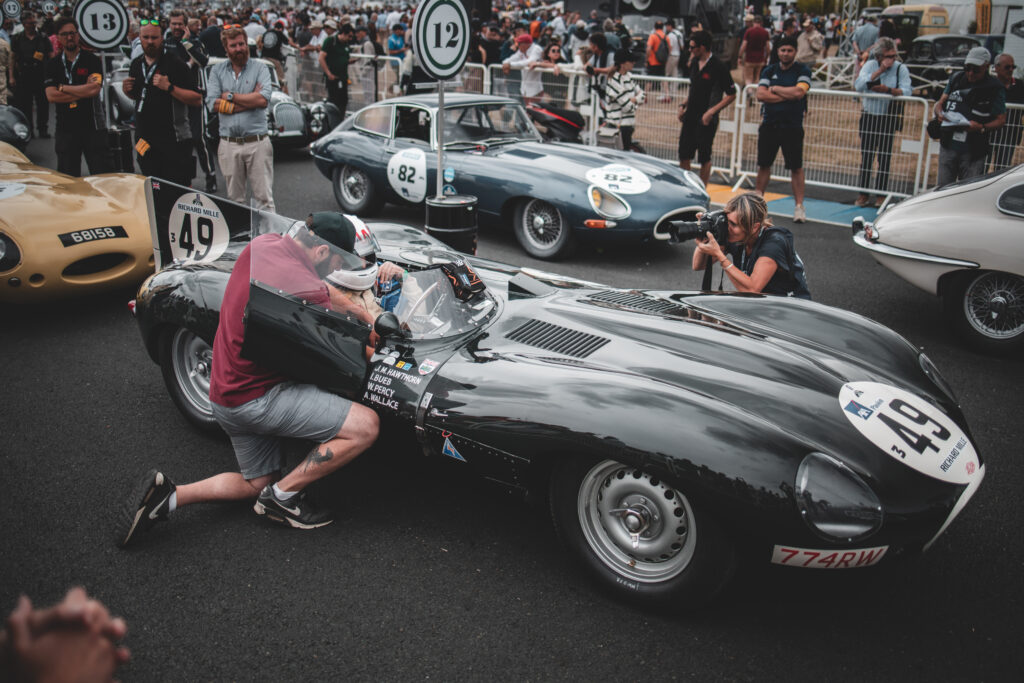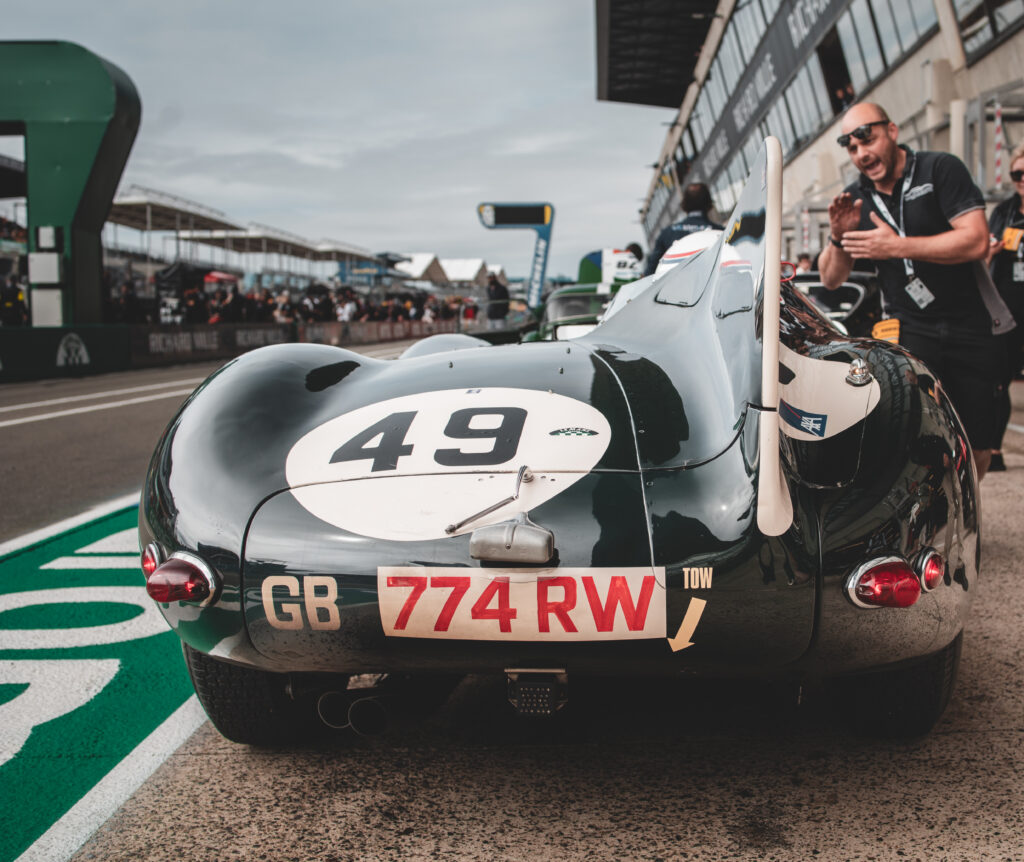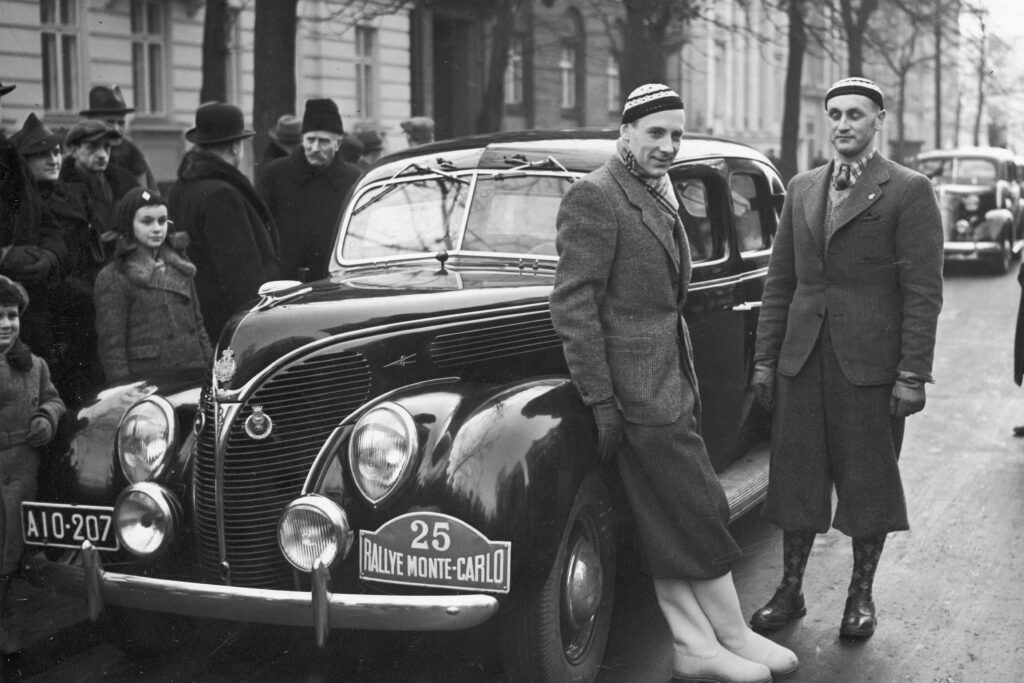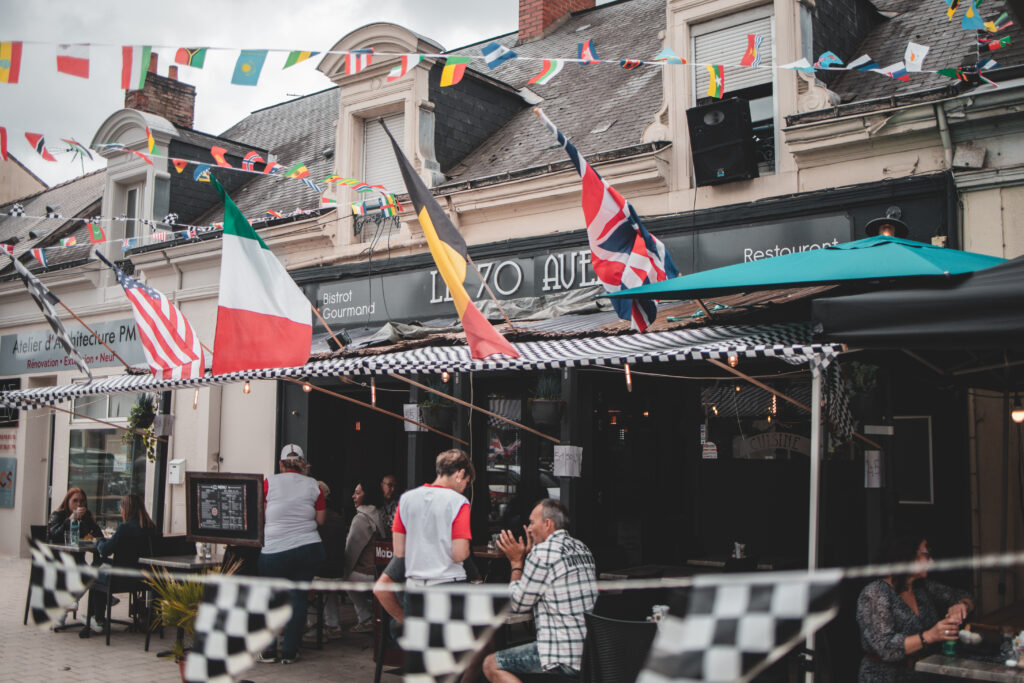This year’s Le Mans Classic was dedicated to one thing – the celebration of the 100th anniversary of the legendary French endurance race. Above all, it was the teams that came to the Circuit de la Sarthe to fiercely compete for victory during this exceptional weekend.
No joking around
Once again, I meet my dear friend Tomek “Jagman” Zieliński in Le Mans, who has been working in Nigel Webb’s collection for over a decade. The well-known Jaguar collector from the Goodwood area has put everything on the line this year to secure a victory for his team. And it wouldn’t be the first time because Jaguar No. 6 Racing triumphed at Le Mans Classic in 2002 and 2016. For the Group 3 race (Plateau 3), Nigel entered the pearl of his collection, the Jaguar D-Type. This particular car won the 24-hour race at the legendary French track in 1955. Exceptionally beautiful yet burdened with a tragic history. The victory of Mike Hawthorn and Ivor Bueb, 68 years ago, is primarily associated with one of the greatest tragedies in motorsport history. When on the 33rd lap, tired Pierre Levegh, overestimating his own abilities, veered off the track and crashed into a grandstand full of spectators, not only the driver but also 82 spectators lost their lives, and 120 were injured. The race was not stopped, but Mercedes, as a sign of mourning, withdrew its cars from further competition and completely ceased its motorsport activities. Hawthorn was blamed for the accident as he abruptly slowed down when deciding to make a sudden pit stop. This was seen as the direct cause of the tragic events in which the Mercedes following the Jaguar with number six on its side was involved. Whenever I talk to Tomek about this car and its history, I get chills all over my body.

Driver for special missions
Our conversation is interrupted by the appearance of a smiling and incredibly friendly gentleman in the pit. For the first time this weekend, I shake hands with Andy Wallace, the triple crown winner of endurance races, with victories at the 24 Hours of Le Mans, 24 Hours of Daytona, and 12 Hours of Sebring. You probably remember the distinctive white and purple Silk Cut Jaguar XJR9 with the number 2 on the side. In 1988, it was behind the wheel of this car that Jan Lammers, Johnny Dumfries, and Andy Wallace won the 24-hour race at Le Mans. It wasn’t an easy feat, as the TWR Jaguar team faced tremendous pressure. The British manufacturer wanted to return to the top step of the podium in the endurance classic after 37 years. Thanks to the Jaguar Daimler Heritage Trust, the victorious Jaguar XJR9 could be admired this year during the Le Mans Legends Parade.
 Andy’s list of achievements is extensive. In 1993, he made the McLaren F1 the “fastest production car” by reaching a top speed of 391 km/h. Twenty-six years later, he achieved the same title with the Bugatti Chiron Super Sport 300+, reaching a speed of 490 km/h. It is this man who will drive the famous Jaguar D-Type of the Jaguar No. 6 Racing team. We talk for a while about his connections with Jaguar. Our casual conversation is constantly interrupted by someone coming to the pit, asking for a photo, an autograph, or simply wanting to chat. Andy never refuses anyone. He has a moment for everyone, and you can see the tremendous warmth in what he does. In Andy’s presence, time flies by!
Andy’s list of achievements is extensive. In 1993, he made the McLaren F1 the “fastest production car” by reaching a top speed of 391 km/h. Twenty-six years later, he achieved the same title with the Bugatti Chiron Super Sport 300+, reaching a speed of 490 km/h. It is this man who will drive the famous Jaguar D-Type of the Jaguar No. 6 Racing team. We talk for a while about his connections with Jaguar. Our casual conversation is constantly interrupted by someone coming to the pit, asking for a photo, an autograph, or simply wanting to chat. Andy never refuses anyone. He has a moment for everyone, and you can see the tremendous warmth in what he does. In Andy’s presence, time flies by!

This car tried to kill me!
After the first qualifying session, Andy succinctly answers the question about his driving experience – “This car tried to kill me!” It turns out that the car had terrible brake problems, most likely due to the manufacturer supplying faulty brake pads. The mechanics also had to deal with a pressure pump replacement. The Jaguar D-Type is equipped with a Plessey pump – an innovative brake booster driven by the gearbox, and therefore dependent on the driving speed. This solution has never worked reliably, and this time was no different, which could be really uncomfortable considering that the car easily reaches speeds of up to 230 km/h. There were also problems with the brand-new suspension, which started to develop looseness under racing conditions. The team will have to deal with them throughout the race. I ask Tomek about their plans to improve the brakes because the qualifying session didn’t inspire much optimism… and just like Tommy Shelby in a crucial moment of the Peaky Blinders series, he lights a cigarette and, squinting through the dense smoke, says, “What can we do? We’ll take it apart! We still have a few hours until the night session. The race is just beginning!” Andy finished the qualifying session in seventh place.

Not the first time
In the meantime, as Tomek gets to work on the car, we talk about what it’s like to work with someone like Andy. The gentlemen have met before in the pit of the Jaguar No. 6 Racing team. Andy had already won Le Mans Classic in 2016 with the same car. Tomek has a beautiful photo hanging in his home, prominently displayed, from that event. The photo shows how he hides a face with eyes full of tears of happiness in his hands. Working with Andy is a pleasure and an honor. This guy is a master; he knows everything about cars and can tell the mechanic exactly what he needs or what doesn’t work. It’s no wonder he works for Bugatti as a test driver – I hear this from a young mechanic from Łódź who is sorting tools in the toolbox. Meanwhile, darkness falls over Le Mans, and the night free practice begins. Unfortunately, the D-Type exits the track after just one lap. It’s because of the rain, which prevented team from checking the brakes. Everything will be decided the next day.

Knight, squire, and me
“Get in! We’ll deliver car to Andy!” You don’t refuse such invitations. From the paddock to the Bugatti Circuit loop, where the cars line up before heading onto the track of the Circuit de la Sarthe, there are a few hundred meters. As a rule, the drivers are already waiting at the spot, and the mechanics deliver the cars. We get into the Jaguar and drive out of the paddock… The D-Type proudly rolls alongside a Ferrari 250 GT and a Porsche 356. On both sides of the road leading to the track, people line up. They wave, take pictures, and they almost pat the cars with approval. What a moment! It’s like being a squire leading horse, and the knight, fully armored and gleaming, is already waiting eagerly for his next duel…

Gentlemen, start your engines!
In the first Saturday race, Andy starts from the third row, a distant position. Uncertainty about the brakes lingers. Wallace drives faster and more confidently, although you can see how the front of the car pitches with each braking into a corner. Experience allows him to win the first race by a mere two hundredths of a second. The car performs better and better but still requires adjustments. The second race takes place at night. This time, the Briton wins with a significant advantage, firmly establishing himself in the lead. The decisive third race is full of drama. Part of the front hood flies off the famous Ferrari 250 GT SWB Breadvan. Emanuele Pirro makes a mistake in a turn and manages to save the car from contact with the barriers. At a crucial moment, the Jaguar No. 6 Racing team also stumbles… a few seconds too early, Andy exits the pit lane and receives a time penalty – a driver who participates in the race without changing drivers must enter the pit lane and wait there for exactly one minute. This causes a loss of precious seconds. Andy drops to fifth place in the third race. The team is in anguish… the officials tally the times. Suddenly, a judge appears and shouts, “We need Andy on the podium!” A little over 21 seconds of an advantage over the Ferrari 250 GT SWB driven by Harrison Newey, Joe Macari, and Christian Hore is enough to claim victory in the jubilee Le Mans Classic race in Group 3! Emanuele Pirro, a five-time winner of the 24 Hours of Le Mans, finishes in 29th place. This time, he shared the wheel of the Lister Jaguar Costin ’59 with Hans Hugenholtz.
The pressure of victory
Two days before leaving for Le Mans, I had a phone conversation with Tomek about their plans. He told me then that they, of course, wanted to fight for victory but faced very strong competition this year. Everyone came to the 100th anniversary of the 24 Hours of Le Mans with the thought that they might win this special Classic race. After returning home, Tomek confessed to me, “You know, I’m a young guy who has worked hard to get to a good place. I put my whole heart into what I do. Nothing is indifferent to me, I give my all, and that puts a lot of pressure and stress on myself.” The immense emotions were evident a few minutes after he received the news of the victory. Tom’s eyes began to well up again, just like in the photo from 2016.
Mechanics don’t take vacations
Being a mechanic means endless overtime, and you really have to love your job to withstand such a pace. The race at Le Mans ended late on Sunday afternoon. The process of packing the car, tools, and camping equipment begins. Everything has to return to England. However, even after returning home, Tomek doesn’t get any rest. On Tuesday, the D-Type, along with the trophy, will go to the Goodwood circuit as an attraction during a track day. Moreover, at Goodwood, the team will be testing two other Jaguars from Nigel Webb’s collection that need to be prepared for the next race… and that race is already on Sunday at Donington Park.

Words by Sławomir Poros Jr.
Photos by Maciej Jasiński & Rafał Pilch



















